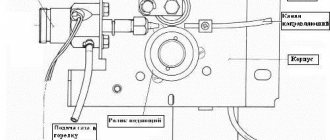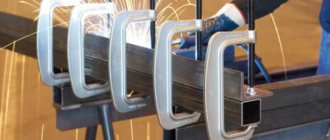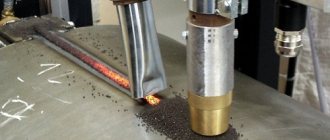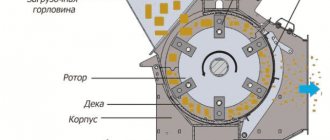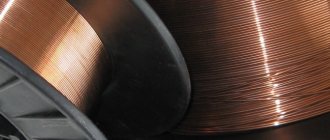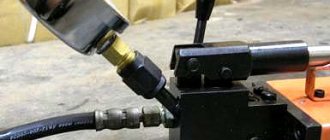Feeding mechanisms (welding wire feeders) are the main device in the semi-automatic welding process. Feeding mechanisms for semi-automatic welding machines - devices for feeding electrode welding wire into the torch.
A cassette with welding wire is installed in the mechanism. The feeding mechanism has a gear drive for feeding welding wire at a certain speed depending on the specified parameters of the welding process. Depending on the thickness of the welding wire, the feed mechanisms can have from 1 to 3 pairs of feed rollers that push the wire into the torch. In addition, for large wire diameters, welding torches with engaging rollers can be used.
Feeding mechanisms for semi-automatic machines produced by ITS are represented by a whole line of devices for working with welding wire with a diameter of 0.8 mm to 5 mm. In addition to the basic configurations, upon special request, the ITS can manufacture a mechanism for working with thicker types of wire, incl. thick flux-cored wire for non-standard welding work.
In accordance with the wire used, the feed mechanisms of semi-automatic ITS can be configured to work with the required parameters of the welding current. Various ITS feed mechanisms are configured to operate with currents from 50A to 700A. The feed mechanisms are connected to welding inverters, the resulting device is called a semi-automatic welding machine. In this case, we mean complete semi-automatic welding machines; in addition to them, there are ITS welding monoblocks, the housing of which combines a feeder and an inverter.
With high voltage, the use of semi-automatic welding is a complex, unsafe and ineffective task; such problems are better solved by automatic welding.
The feeding mechanisms of semi-automatic ITS machines have a one-year warranty, and additional components and spare parts are always in stock.
The main models of feed mechanisms produced by ITS:
Feeding mechanisms
| Name | Number of rollers, pcs. | Rated welding current, A (PV) | Wire feed speed, m/h | Wire diameter, mm | Welding cassette capacity | Dimensions, mm | Weight, kg | ||
| Steel | Powder | Self-protective | |||||||
| PDG-312-5 | 4 | 315 (60%) | 40-960 | 0,8-1,6 | — | — | 15 | 630x280x500 | 20 |
| PDG-322 | 2 | 315 (60%) | 70-930 | 0,8-1,4 | — | — | 15 | 160x430x270 | 7,5 |
| PDG-421 | 4 | 400 (60%) | 60-960 | 0,8-1,4 | 1,2 | — | 5 | 490x185x295 | 12 |
| PDGO-510* | 4 | 500 (60%) | 120-1100 | 1,0-1,6 | 1,2-2,0 | — | 15 | 640x240x420 | 18 |
| PDGO-511 | 4 | 500 (60%) | 60-960 | 0,8-2,0 | 1,2-2,0 | 1,6-2,0 | 15 | 440x290x530 | 17 |
| PDGO-601 | 4 | 630 (100%) | 60-820 | 1,2-2,0 | 1,2-3,2 | — | 15 | 640x240x420 | 18 |
| PDGO-602** | 4 | 630 (100%) | 104-980 | 1,2-2,0 | 1,2-3,2 | — | 15 | 560x350x360 | 26 |
| PDGO-603 | 4 | 630 (100%) | 104-980 | 1,2-2,0 | 1,2-3,2 | — | 30 | 1000x500x400 | 28 |
* - the standard production program also includes a modification of the PDGO-510 feeding mechanism - PDGO-510A
(supplied with an autonomous BUSP-2K-506/24V).
**- PDGO-602 has stepwise regulation of the electrode wire feed speed (28 steps) using replaceable gears
Feeding mechanism PDG-312-5
| Feeding mechanism PDG-312-5 is closed type. Inside there is a 2-roller gear drive CWF 3110, a cassette for welding wire, a braking device, a control board and a solenoid valve. On the mechanism panel there are resistors for adjusting the welding wire feed speed and voltage, and technological time intervals. There is a version PDG-312-5 with digital indication of welding modes and a four-roller feed drive. More details: |
Feeding mechanism PDG-401
| The PDG-401 feed mechanism is designed for semi-automatic DC welding with consumable electrode wire in a shielding gas environment, complete with sources for MIG/MAG welding. Smooth adjustment of the output voltage of the welding source and the feed speed of the electrode wire from the feed mechanism. Provides stabilization of the welding wire feed speed and voltage feedback on the welding wire feed motor, which allows for high-quality welding at a distance of up to 40 meters from the welding source. Stable feed speed of welding wire with a torch train length of 3 - 5 m and bends in the train. More details: |
How to use a welding inverter
After starting the semi-automatic device that you assembled with your own hands, the inverter indicator should display a current value of 120 A. If everything is done correctly, then this will happen. However, the inverter indicator may display a figure of eight. The reason for this is most often insufficient voltage in the welding wires. It is better to immediately find the cause of such a malfunction and promptly eliminate it.
If everything is done correctly, the indicator will correctly show the strength of the welding current, which is adjusted using special buttons. The operating current adjustment interval provided by welding inverters is in the range of 20–160 A.
Approximate modes of semi-automatic welding of butt seams
Feeding mechanism PDG-421
| Feeding mechanism PDG-421 is a closed type (“Admiralteets”), inside of which a 4-roller gear drive CWF 4110, an electromagnetic valve, a control board and a gas path are installed. The welding mode controls are located on the front panel of the feed mechanism. The connecting unit with the burner is made with a plug-in connection. A version with a Euro connector is possible. The difference from the PDG-322M feeder is that the control board in the PDG-421 feeder is located inside the feeder housing and does not have the same functionality as the PDG-322M. More details: |
Setting up an inverter used for semi-automatic welding
If you decide to make a semi-automatic welding machine with your own hands using an inverter, you must first turn off the power to this equipment. To prevent such a device from overheating, its rectifiers (input and output) and power switches should be placed on radiators.
Power diodes on additional radiators
In addition, in the part of the inverter housing where the radiator is located, which heats up more, it is best to mount a temperature sensor, which will be responsible for turning off the device if it overheats.
After all of the above procedures have been completed, you can connect the power part of the device to its control unit and connect it to the electrical network. When the network connection indicator lights up, an oscilloscope should be connected to the inverter outputs. Using this device, you need to find electrical pulses with a frequency of 40–50 kHz. The time between the formation of such pulses should be 1.5 μs, which is regulated by changing the voltage value supplied to the device input.
Oscillogram of welding voltage and current: on the left with reverse polarity, on the right with direct polarity
It is also necessary to check that the pulses reflected on the oscilloscope screen are rectangular in shape, and their front is no more than 500 ns. If all the checked parameters correspond to the required values, then you can connect the inverter to the electrical network. The current coming from the output of the semi-automatic device must have a force of at least 120 A. If the current value is less, this may mean that voltage is supplied to the equipment wires, the value of which does not exceed 100 V. If such a situation occurs, you must do the following: test the equipment by changing the current (in this case, it is necessary to constantly monitor the voltage on the capacitor). In addition, the temperature inside the device should be constantly monitored.
After the semi-automatic machine has been tested, it is necessary to test it under load. To make such a check, a rheostat is connected to the welding wires, the resistance of which is at least 0.5 Ohm. Such a rheostat must withstand a current of 60 A. The strength of the current that in such a situation flows to the welding torch is controlled using an ammeter. If the current strength when using a load rheostat does not meet the required parameters, then the resistance value of this device is selected empirically.
Feeding mechanism PDGO-510
| Feeding mechanism for welding wire PDGO-510. Used as part of a complete semi-automatic welding machine. Connects to a welding source for MIG/MAG welding. Serves to supply a welding consumable electrode and shielding gas to the welding point. As a consumable electrode in the PDGO-510 feeding mechanism, it is allowed to use solid types of welding wire, as well as various types of welding flux-cored wire. PDGO-510 allows any type of shielding gas, depending on the type of wire used. The PDGO-510 control board allows you to switch welding modes from 2-stroke to 4-stroke, provides the functions “soft start” and arc stretching,” Inter Lock – arc breaking. Gas purging is carried out automatically before and after welding. More details: |
Semi-automatic welding machine
Welding machines of this class are available in different modifications. The specific name, “semi-automatic”, means that you will have to perform certain actions yourself. However, special equipment makes it possible to simplify many operations, so using such equipment it is quite possible to create high-quality welded joints without assistants. Of course, this will require studying relevant technologies and acquiring sustainable practical skills.
Type of semi-automatic welding machine
Work principles
To connect parts using this method, heating the areas of future contact is used. The molten areas unite and, after lowering the temperature, form a strong solid unit. The following are issues that developers of relevant technologies pay attention to:
- The heating must be intense enough for the metal to begin to melt after processing.
- On the other hand, it is necessary to ensure only local impact so that the structure of neighboring areas is not damaged.
- You should also take into account the activation of oxidative processes and the possible penetration (into the area of molten metal) of impurities from the surrounding air. Such “additives” can worsen the strength and other initial parameters of materials.
The listed tasks are successfully solved by the welding machine. Heating in it is created by an electric arc. It is formed between the electrode and the metal surface when voltage is applied to them. Since a high current is used for a powerful continuous discharge, the relatively small-sized working spark gap quickly burns out. In order to avoid replacing it frequently, a thin wire is used, which is fed at the required speed into the work area. To eliminate the harmful influence of the environment, a neutral gas supply is also provided here.
Structure of a semi-automatic device
Equipment parts, their purpose and important features:
- Power supply. When creating an arc, a voltage of several tens of volts up to 200 amperes and more is generated. The power consumption of many production models is in the range from 5 to 6 kW. These figures are given in order to more accurately estimate the requirements for the power supply.
- Control devices are designed to adjust the wire feed speed and set the welding current level.
Signal indicators notify about connection to the network, the occurrence of critical operating modes and emergency situations.
- The wire for connection to the parts to be joined by welding is equipped with a special spring clamp.
- The burner is connected through a flexible hose to the body. There is a pipeline and hose running inside. They are designed for dosed supply of wire and gas into the work area.
- If the structure turns out to be heavy, then rotating wheels are installed in the bottom to move it.
- The wire wound on a reel is installed inside the housing. Its supply is carried out by pushing, pulling, or a combined drive.
View of a semiautomatic device with the housing cover removed
Technical specifications
Before finding out how much this or that semi-automatic welding machine costs, you need to determine the range of tasks that will have to be solved in practice. This will help you choose equipment that is not too expensive, but quite suitable in terms of its technical parameters.
Professional equipment is sometimes called equipment that is capable of providing current in excess of 300 A. In practice, such values are rarely required. For many experienced craftsmen working in automobile service centers, 200-250 A is quite enough.
A certain power reserve will not be superfluous. It will allow you to operate in nominal modes, without excessive loads, which will extend the service life of the equipment even with intensive use.
However, if a semi-automatic machine is intended to be used from time to time, to solve personal everyday problems, then such special requirements will be clearly unnecessary. But in any case, you need to study in more detail the technical characteristics of the equipment model you like.
The 220 V power supply is better suited for domestic use; you don’t have to look for a special power source. But professionals note the advantages of a three-phase 380 V network. As a rule, such wiring is better suited to increased loads. The use of three phases allows you to obtain a discharge with more stable parameters, which has a positive effect on the quality of welding.
Semi-automatic, which connects to a 220 V network
If you purchase a universal semi-automatic machine, it will be able to operate on 220 V, or 380 V with the appropriate connection. Permissible voltage deviations do not exceed 15-20%.
As the voltage decreases, power consumption and current will decrease.
The recommended rated current of the power supply must be checked. Its value can be 15-25 A. The wiring must be designed for the appropriate loads.
It is necessary to pay attention to the duration of constant switching on at maximum current. This parameter is indicated as a percentage. If it is equal to 60% at 180A, this means that at the highest permissible load the semi-automatic device can operate for 6 minutes, after which a four-minute break will be required to cool the equipment. The time intervals of the standard work cycle (10 min.) are determined in a similar way for other parameter values.
The following designations are used in the descriptions:
- MIG is an abbreviation for Metal Inert Gas. It determines that the equipment is intended for welding metals in argon, or other inert gas, or their mixtures in certain proportions. Consumables in this case are more expensive, but the weld is reliable even without additional protection.
- MAG is an acronym for Metal Active Gaz. This technology uses carbon dioxide protection. Compared to the first option, in this environment the quality of the weld is slightly worse. It is recommended to subsequently clean the created joint and coat it with anti-corrosion agents.
Overall dimensions and weight should also be studied carefully. When performing complex work in limited space, they will be of decisive importance.
What does a compact welding machine look like?
The length of the gas hose, return cable with clamp - these data are checked to determine the radius of the working area (when the device is installed permanently).
The range, step of change in operating voltage and welding current, the speed at which the wire is fed determine the possibility of using different welding modes, working with different metals, and the sizes of the parts being connected.
Maximum diameter of electrodes (tungsten, alkaline and others). Using this information and special tables, you can determine what thickness of products made from certain metals and alloys this machine is capable of welding.
Protection and insulation classes are important when performing work in rooms with high humidity or in other unfavorable and dangerous conditions.
If the efficiency factor is given, then it will be possible to evaluate the efficiency of the device’s use of energy resources. In modern high-quality models, this parameter reaches 85% or more.
Types of welding equipment
It is clear that the potential capabilities of this technology are largely determined by the parameters of the electrical power part. Previously, only circuits with transformer conversion of current and voltage were used. They provided the required result, but were characterized by large dimensions, insufficiently precise adjustment and maintenance of operating parameters.
These days, such engineering solutions are used less and less. Welding machines with frequency converters are more common.
A typical inverter works as follows:
- For power supply use a standard network (220 V, or 380 V (three phases) 50-60 Hz).
- The alternating current is rectified and filtering is used to remove the remaining ripple.
- Transistors and other electronic devices that perform the functions of switches convert the current into alternating current. But, compared to the original value, the frequency is increased many times, up to 40 - 55 kHz.
- At the next stage, the voltage is reduced to 20-80 V, which makes it possible to obtain a strong current (20 - 300 A) at the output of the welding machine, sufficient for welding procedures.
The inverter device is much more convenient and functional than its outdated analogues. It is significantly, several times, lighter. It can easily be moved by one person.
Experts appreciate the following advantages of this type of technology:
- The compact inverter welding machine can be carried using a shoulder strap. Its placement requires a minimum of space, so it becomes possible to carry out the most complex work procedures in cramped conditions.
- The development of production technologies and the reduction in cost of electronic components have reduced prices for equipment of this class. A high-quality inverter welding machine is inexpensive. It is quite accessible even for private users.
- The inverter is precisely tuned to work with a certain thickness and material of parts. In some models, the current is adjusted smoothly over a wide range. Such capabilities, when used correctly, allow you to obtain impeccable quality of the welded joint.
- The inverter welding machine maintains the set current value accurately. There will be no need for additional adjustments by the user, which also has a positive effect on the performance of work processes.
- A modern inverter semi-automatic device is well protected from voltage surges in the network. It is adapted to work in difficult conditions and retains its technical characteristics unchanged during long-term operation.
An inverter welding machine gets very hot, so this equipment is often equipped with fairly powerful forced air cooling systems. When constantly working in dusty rooms, preventive measures are regularly taken, carefully removing any contaminants that have gotten inside by removing the housing.
Inverter cooling must be quite efficient
Wire selection
Different values should be taken into account for wire made of steel, titanium, copper, other metals and alloys. Nowadays, more than 70 different modifications of products designed for various types of welding are produced. They are classified into the following main groups:
- MIG (MAG) welding wire, which has a solid structure and is designed to perform work operations in a protective gas environment.
- Hollow products with fillers. When used, they create local protection in the heating area.
- Wires for welding using argon arc technologies. They contain special additives
- Products that are intended for forming welded joints using flux.
Certain types of wires are created for welding low-alloy, high-strength, stainless and carbon steels, copper, cast iron, nickel and aluminum products. In the standard designation, the first group of numbers indicates the percentage of carbon (“09” is 0.08%). The smaller the parameter, the higher the ductility of the wire.
Wire for welding machines, ready for installation, on special reels
A semi-automatic welding machine operating with currents up to 200-250A inclusive is equipped with feed mechanisms designed for wire with a diameter of 0.6 to 1 mm. As power increases, technicians install the appropriate equipment.
Technical and performance parameters that must be used in practice for calculations and adjustments
Wire diameter, mm Thickness of metal parts, mm Voltage between the electrode and the welding area, V Welding current (range in A) Shielding gas supply rate, l per min Speed of weld creation, m per hour of continuous operation
| 0,6 | 0,5-1,5 | 16-20 | 40-100 | 6-7 | 25-35 |
| 0,8 | 0,8-2,5 | 17-25 | 50-180 | 7-12 | 22-32 |
| 1 | 1,0-4,0 | 18-28 | 60-250 | 8-16 | 20-30 |
| 1,2 | 1,5-8,0 | 18-32 | 70-350 | 9-20 | 18-28 |
| 1,6 | 2,0-20 | 20-36 | 100-500 | 10-22 | 16-25 |
Setting up the welding machine when using wire with a certain diameter
Wire diameter, mm Voltage between the electrode and the welding area, V Welding current (range in A) Distance in mm from the welding area to the torch nozzle Electrode extension in mm
| 0,6 | 16-20 | 40-100 | From 5 to 15 | From 6 to 10 |
| 0,8 | 17-25 | 50-180 | From 5 to 15 | From 8 to 12 |
| 1 | 18-28 | 60-250 | From 8 to 18 | From 8 to 14 |
| 1,2 | 18-32 | 70-350 | From 8 to 16 | From 10 to 15 |
| 1,6 | 20-36 | 100-500 | From 15 to 25 | From 14 to 25 |
As a standard, a welding machine of this type is equipped to work with steel wires of the above standard sizes. But if it is intended to weld aluminum products in an argon environment, then special feed mechanisms are used, designed for a relatively large wire diameter and low strength.
For uniform advancement, the tips are coated on the inside with Teflon and other materials that provide a low coefficient of friction.
Flux-cored wire contains special additives. When an electric arc and high temperature are formed, they evaporate, creating a protective environment in the welding working area. This solution eliminates the need to use inert gas. With its help, you can do away with heavy cylinders, eliminating the worries and costs associated with the use of these containers. They must be transported and stored under special conditions and additional safety measures must be observed during operation. You will need to spend time and money on the recertification procedure.
Types of wires with fillers
Cored wires provide less reliable and uniform protection. They quickly pollute the atmosphere with harmful compounds, so their use in enclosed spaces is limited.
Welding using a semi-automatic machine
This technology differs significantly when working with different metals, shapes and thicknesses of parts. The following is an algorithm for the main actions and features that experienced craftsmen take into account in the process of welding aluminum products.
What does semi-automatic welding look like?
This metal is characterized by low density, low strength, high electrical and thermal conductivity. It melts at + 660 °C, and a film of oxides, which very quickly forms on the surface, at temperatures above + 2000 °C. The given data defines the basic conditions for high-quality welding:
- With high thermal conductivity, it is necessary to use high current and a short distance from the electrode to the products being connected. This can be provided by a semi-automatic inverter welding machine.
- Such a device is useful for accurately setting the optimal current strength, because aluminum parts can be quickly burned through.
- Even an experienced specialist will not be able to ensure that a crater does not form on the weld. A semi-automatic machine is also well suited for eliminating such defects.
Welding of aluminum parts is performed as follows:
- They ensure the absence of pollution in the room atmosphere, maintain air temperature in the range from + 18°C to + 22°C with a humidity of no more than 65-70%.
- Remove mechanically and with the help of special chemicals oxides, fats and other contaminants from surfaces.
- The protective environment is created with gas - argon. Select the wire and set the modes that correspond to the parameters of the elements being connected.
- When performing work, use a mask, gloves, and other personal protective equipment.
Video. Semi-automatic test
Modern semi-automatic machines are easier to set up. They have control units with built-in different operating modes. After entering the initial data, the optimal current strength and other parameters will be set. However, much depends on the skill of the performer. That is why, to obtain a high-quality and reliable welding connection, you need not only the most advanced apparatus, but also training that will help you accumulate the necessary practical experience.
elquanta.ru
Feeding mechanism PDGO-510A
| Feeding mechanisms PDGO-510A-1, PDGO-510A-2, unlike PDGO-510-6, operate in conjunction with a unit with PWM control type BUSP-2K - 24 V, its modifications or similar control units. The semi-automatic machine PDGO-510A-1 has an increased force of pushing the welding wire at low speeds, due to the use of a high-power engine, which is important when welding with large diameter wires, more than 1.6 mm. Feeding mechanisms PDGO-510A-1, PDGO-510A-2, unlike PDGO-510-6, operate in conjunction with a unit with PWM control type BUSP-2K - 24 V, its modifications or similar control units. More details: |
In what cases is a semi-automatic welding machine used?
Practice shows that it is better to use a semi-automatic machine in cases where it is necessary to obtain precise and accurate connections of parts made of steel. With the help of such equipment, which, if desired, can be made by hand, welded joints of thin metal are made, which is very important when repairing the body of a vehicle.
Learning how to operate such a device is also not difficult: lessons taken from qualified specialists or a training video will help you with this.
Feeding mechanism PDGO-510T
| Feeding mechanism PDGO-510T is semi-closed type. PDGO-510T is designed to work with rectifiers of the VD-506DK type. Inside the feed mechanism there is a 4-roller gear drive CWF 5110, an electromagnetic valve, a welding cycle control board, a voltage feedback board on the welding wire feed motor and a gas path. Adjustment resistors are installed inside the housing of the feed mechanism to adjust the time of gas purging before and after welding, and the sticking out of the welding wire. Welding mode controls are located on the front panel (resistors for adjusting the welding wire feed speed and arc voltage). More details: |
Design and configuration of a wire feed mechanism in a semi-automatic machine
Semi-automatic welding machines are a convenient and common type of welding equipment. The productivity of semi-automatic welding depends on the correct adjustment of all its technological parameters, including the welding wire feeding mode. This function is performed by a special wire feed mechanism for a semi-automatic machine. Modern designs allow you to adjust the speed in the range of 50-600 mm/s.
Design options
The initial requirements for the unit in question are its versatility, relatively fast adaptability, the ability to work with wire of various diameters, compactness and the ability to control the speed of movement of the wire to the welding zone.
The typical design of this unit includes:
- The reel on which the cassette with the source material is mounted.
- Drive asynchronous three-phase AC motor, which is designed to operate with a relatively low operating voltage (not higher than 36 V).
- Multi-stage worm gearbox, with which you can change the speed of wire movement.
- Replaceable gears from which the feed rollers rotate.
- A set of feed rollers that can be axially adjusted to suit different diameters of welding wire.
- Feed sleeve, which, depending on the placement of the unit, ensures the movement of material outside its body.
- The supporting frame on which all the elements of this unit are placed. The frame can be equipped with transport wheels.
- Wire pre-tensioning unit (installed before the rollers).
The layout of the individual units that make up the wire feed for a semi-automatic machine depends on the wire feed method. It can be pulling, pushing and mixed.
The pulling option is provided in the case when the power of the drive electric motor is not enough to pull the wire with rollers at the maximum required speed. To do this, the pulling mechanism is located in the handle of the welding torch. Although this makes the torch itself heavier, it contributes to a more uniform speed of movement, which is especially important for ensuring improved quality of the weld and stability of its overall dimensions. To ensure that the welder’s hand does not get tired, a special stand is provided. As a result, this design is less common, since it is designed mainly for professional welders.
With the pushing version, all moving parts are located in the body of the unit itself, and precise direction is ensured by appropriate adjustment of the guide sleeve, which is located after the drive rollers. This arrangement requires that the feed unit be located near the welder's station. If any problems arise with this mechanism, welding will be interrupted, which will inevitably affect its quality. Therefore, push feed is more demanding on the reliability of the drive motor.
Combined feed, when the unit has both pushing and pulling drives, is the safest: if problems arise inside the housing, the movement will continue with an autonomous device, which is mounted in the welding torch. Nevertheless, this scheme is characterized by the greatest complexity, and therefore is used forcedly: for example, when there are significant distances between the semi-automatic device and the feed mechanism. The most powerful standard sizes of semi-automatic welding machines are equipped with a push-pull feed.
Thus, the choice of the most suitable welding wire feeding mechanism for a semi-automatic machine depends on the welding conditions and the qualifications of the worker.
How to configure a node
Preliminary adjustment operations are greatly facilitated if the semi-automatic welding machine is equipped with an electronic control unit. In this case, changing the speed of movement of the welding wire can be done using the so-called proportional control, when the intensity of pressing the control button slows down or accelerates the rotation of the feed rollers.
This happens as follows. An induction motor can change the rotor speed in several ways:
- Increased rotor slip. The method has a significant drawback - increased power losses with subsequent overheating of the engine. Therefore, it is suitable only for short-term control mode and with wire of small diameters, when the feed force is significantly less than the torque that the electric motor develops;
- By including additional resistors in the rotor circuit, which will slow down its rotation. In this case, the adjustment is made only in steps, and the overall dimensions of the device increase, which is not always acceptable;
- By changing the voltage on the stator, which is performed by a special electronic voltage regulator. This method is the most modern - there are practically no electrical losses, and the engine is not overloaded, but the cost of the mechanism in this case will be the highest.
Proportional control also allows the voltage regulator to be switched on gradually. Because of this, the speed of the rollers will change smoothly, and the braking torque from the inertia of the supplied material is minimal. As a result, wire breakout is virtually eliminated.
In addition to adjusting the rotation speed of the rollers, modern welding wire feeding mechanisms allow you to control other parameters. For example, by the force of pressing the wire with rollers.
Smooth feeding is ensured by increasing the number of feed rollers. There are usually five of them: two rollers (pressing) are located at the top, and the rest (feed) are located below the wire feed axis. The initial gap between the upper and lower rollers must be equal to the thickness of the wire: only in this case will the friction grip be reliable. However, welding wire in most cases is made of soft, low-carbon steel, which is plastically deformed, and copper-plated wire, in addition, also reduces the coefficient of friction. Therefore, before turning on the device for the first time, the front end of the wire is sharpened and in this state is inserted into the gap, after which the rollers are shifted to a distance that is guaranteed to ensure reliable clamping of the material to the working surfaces of the rollers.
The last stage of adjustment is to adjust the tension of the welding wire unwinding from the cassette. This is done using a union nut, which is provided on the feed mechanism housing.
The kit of the considered unit also includes replaceable pairs of gears, with the help of which the mechanism can be readjusted for a different wire diameter.
Thus, the adjustment of the feed unit is carried out as a result of sequential adjustment of the rotation speed of the electric motor, the force of pressing the rollers to the material and changing the dimensions of the feed rollers.
wikimetall.ru
Feeding mechanism PDGO-511
| The closed-type feed mechanism PDGO-511 is designed for semi-automatic welding with solid and flux-cored wire at direct current in a shielding gas environment, complete with sources for MIG/MAG welding. The feeding mechanism consists of two frame blocks and a standard 15 kg cassette covered with a casing. The PDGO-511 feeding mechanism is designed to work in difficult working conditions with rectifiers such as VD-306DK, VD-506DK, VDU-506S-4 and others with a rigid or combined characteristic. Inside the lower block of the feeding mechanism there is a 2-roller gear drive with a pressure adjustment device, an electromagnetic valve and a gas path. The upper block houses the welding process control board and process controls. More details: |
Operating principle
An ordinary feed mechanism consists of a DC electric motor, a reduction gear, a pressure and drive roller, a guide and an input channel. In addition, there is a lever with a spring and a screw that acts as a pressure regulator.
When voltage is applied to the electric motor, its shaft begins to rotate at a certain speed. On the same shaft with the electric motor there is a gearbox that reduces the number of revolutions to the required number.
The output shaft of the gearbox rotates the push/pull roller, which in turn pulls the welding wire pressed against it by the second roller. To eliminate slippage, there is an adjusting screw that acts on the pressure spring. It is necessary for a softer and more constant effect on the roller.
The feed mechanism in a semiautomatic welding machine may have a separate adjustment unit, activated from a button on the torch handle. Some models have replaceable bushings on the guide channels.
This allows you to reconfigure the equipment for different wire diameters. In addition, the mechanisms are designed with a valve and fitting for connecting water-cooled burners.
Some four-roller devices have an additional pair of rollers in front of the feed block. Their task is to level the additive. They are usually used when using flux-cored wire with a thickness of 0.8 mm to 4 mm.
Feeding mechanism A-547U
| The A-547U feed mechanism is designed for welding steel products with steel wire in a shielding gas environment using direct current. The semi-automatic device consists of a feed mechanism A-547, a semi-automatic control cabinet and a rectifier VS-300B. Feeding mechanism A-547U is a closed type without a control board. The control circuit is mounted in a separate cabinet. The A-547U feeding mechanism is equipped with a 2-roller gear drive, a cassette for welding wire, a brake device and an electromagnetic valve, and a resistor for adjusting the welding wire feed speed. More details: |
Semi-automatic Sanych
Craftsman Sanych offers a semi-automatic welding circuit that is simple and accessible even for beginners.
The proposed design is characterized by a soft hiss of the arc, while crackling and clicking noises are observed in magazine devices. The hard mode is obtained there due to the output characteristics of the transformer 18–25 V.
The transformer consists of four cores from the TS-270 connected together. The result is almost 2 thousand watts. This power is sufficient with reserve. The primary winding (180+25+25+25+25) is made of wire with a cross-section of 1.2 mm. For the secondary (35+35 turns) an 8 mm² bus is used. The number of turns of the secondary winding is determined last, so it is better to make a couple of turns in each arm with a reserve. The excess can be rewinded.
Welding device diagram:
The rectifier circuit is full-wave. To switch the current there is a paired bib. Two diodes in a small radiator. It is recommended to take capacitors of at least 30 thousand microfarads.
The power part is switched on by any of the powerful contactors, for example models KM-50D-V or KP-50D-V. With the passport data 27 V and at 15 V they work stably. The contactor allows you to obtain high switching power at the lowest current of 300–400 mA.
The TS-40 supply transformer is rewound to give an output voltage of 15 V.
For the broaching mechanism, a roller with a diameter of 25–28 mm is used. On the guide you need to make a groove 0.5 mm wide by 1 mm deep. It is secured to the motor shaft with a nut. The output of the regulator is 6 V, and this is enough for optimal supply. If the lower limit is exceeded, a stabilizer with a lower operating voltage is selected.
The handle holder is machined from textolite sheets 10 mm thick. The seats are made with a drill using drills and an end mill.
The protection hose is held in place on both sides by spacer sleeves. For reliability, there are grooves on the mating parts.
The body will require a 1 m thick sheet of iron with a double flange along the edge. The cooling fan is installed on the rear wall, just opposite the power transformer. The semi-automatic welding machine moves on wheels.
The assembled semiautomatic device is connected to the network for testing. It should not overheat and clearly respond to current adjustment. The transformer insulation is also checked. In case of problems, additional coating is applied. You also need to check the feeding mechanism: how evenly and quickly it feeds the wire. The device has worked faithfully for more than 10 years.
A well-made semi-automatic machine will serve its owner for a long time and reliably, and if you have experience in making a semi-automatic welding machine with your own hands, be sure to share it in the comments to this article.
A semi-automatic welding device for household needs can be purchased ready-to-use or completely assembled with your own hands. A homemade semi-automatic machine will cost the performer much less, but its assembly will require certain skills in working with electrical equipment. The appearance of such a welded device is shown in the figure below.
We recommend that everyone who wants to make a semi-automatic machine from an inverter with their own hands first familiarize themselves with the structure of this unit and the operating features of the modules included in it.
Universal trolley for feeder
| Universal trolley for feeding mechanisms PDG-401, PDGO-508S, PDGO-510, PDGO-510T, PDGO-601S. The trolley is designed for transporting the feeding mechanism in a workshop environment. The trolley is equipped with a universal unwinder for placing a coil of welding wire weighing up to 50 kg. More details: |
- Feeding mechanism PDG-312-5
- Feeding mechanism PDG-322
- Feeding mechanism PDG-401
- Feeding mechanism PDG-421
- Feeding mechanism PDGO-510
- Feeding mechanism PDGO-510A
- Feeding mechanism PDGO-510T
- Feeding mechanism PDGO-511
- Feeding mechanism A-547U
- Feeding mechanism PDGO-601
- Feeding mechanism PDGO-602
- Feeding mechanism PDGO-603
- Universal trolley for feeder
- Feeding mechanism PDGO-518
